
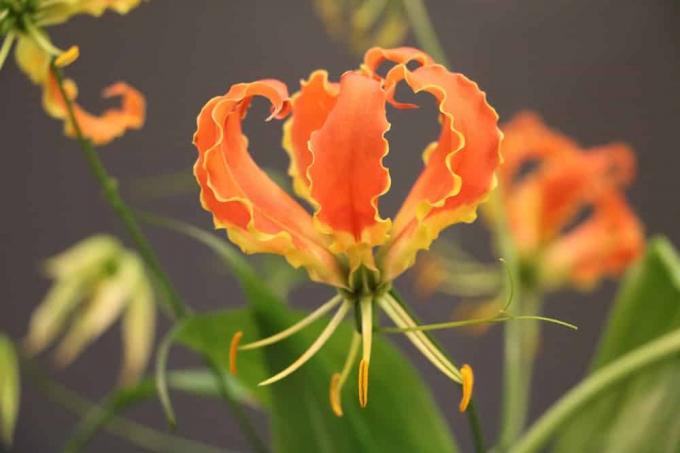
Table of contents
- General
- Location
- Flowering period from June to September
- substrate
- planter
- Pour
- temperature
- propagation
- repot
- Fertilize
- hibernate
- Cutting / poison content
- Diseases / Pests
- aphids
- Plant
- Care
- frequently asked Questions
With the African climbing lily Gloriosa rothschildiana draws an unusual beauty into the garden. Her origin is Africa. Graceful and attractive, this lily climbs a good 2 meters up a trellis. The beautiful exotic lily blossoms emerge from the leaf axils on the long stalks and set dreamlike accents.
Anyone looking for something special for the terrace or garden will be able to fulfill their dream with the African climbing lily. It is the only climbing lily and therefore something very special for every lover of the unusual. Their strength of expression lies in the color of their flowers and their perfect beauty.
General
- Their trivial names are: magnificent lily, flame lily or tiger claw
- It belongs to the plant family of the Colchicaceae, the perennials
- The name of this species is 'Crown of Fame'
- The scientific name is Gloriosa rothschildiana
- Home are the tropics and subtropics
- A climbing plant whose tendrils grow up to 2 meters long
- Rhizomatous rootstock
- Not hardy
- The flowering period begins in February in the greenhouse and in June outdoors
- The flowers are often crimson with yellow, wavy edges
- It is one of the highly poisonous ornamental plants
Tip:
The water balance plays a central role in all tropical plants. Care therefore requires a little attention.
Location
All known species of African climbing lily need a lot of light and sun. A bright, sunny and wind-protected place outdoors is just right in summer.
- sheltered, bright location
- No blazing sun, because of the risk of sunburn
- Temperatures between 18°C and 22°C are ideal
- in summer the minimum temperature is 17°C
Flowering period from June to September
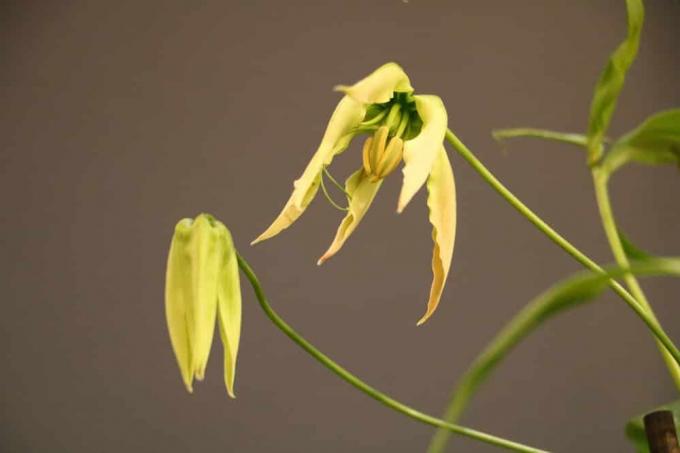
When the ice saints are over, the Gloriosa rothschildiana can be moved to the garden site. Large temperature and air fluctuations should be avoided, otherwise the flowers and leaves will turn brown.
substrate
The magnificent lily grows in its homeland in nutritious and humus-rich soil. The substrate in the planter in which the plant is cultivated should also be like this.
- A mixture of equal parts potting soil, sand and peat is ideal.
- As an alternative, a mixture of equal parts of leaf soil, compost and perlite is also possible.
- The mixture should be well drained, humic and nutritious
- Waterlogging inevitably means the end of this magnificent plant.
planter
Since the African climbing lily has a great urge to climb, it is ideally cultivated in a planter that has a trellis. Mobile flower boxes with a trellis have proven themselves here. Not only can they be used flexibly, they also serve as decorative privacy screens. To consider when planting:
- The planter must have a drainage hole for watering
- Above that comes drainage made of potsherds or small stones
- Fill in the substrate and do not plant the plant deeper than it was in the previous pot
- Be sure to leave a pouring edge of a good 5 cm free
- Water the crown of glory well after planting
If the location and care are good, the magnificent lily quickly climbs up the trellis. Despite the existing natural adhesive organs, their tendrils should be tied in a circle. This allows for a nice dense growth.
Tip:
The binding material must not hinder the growth of the plant. Do not constrict or injure the shoots.
Pour
From the beginning of the growth period, the plant needs water regularly. The substrate should not dry out between waterings. Waterlogging must be avoided.
- keep the roots constantly moist without waterlogging them
- the substrate must not dry out
- The root can also get water from below through a saucer with a wick
- spray the blossoms and leaves with lime-free, slightly warm water on particularly warm days
- in closed rooms, a humidifier can provide the necessary humidity
Tip:
If you place the magnificent lily on a saucer filled with pebbles and water, the air is additionally enriched with water particles by simple means due to evaporation.
temperature
The African climbing lily is best cultivated in a temperature range of 17°C to 20°C.
propagation
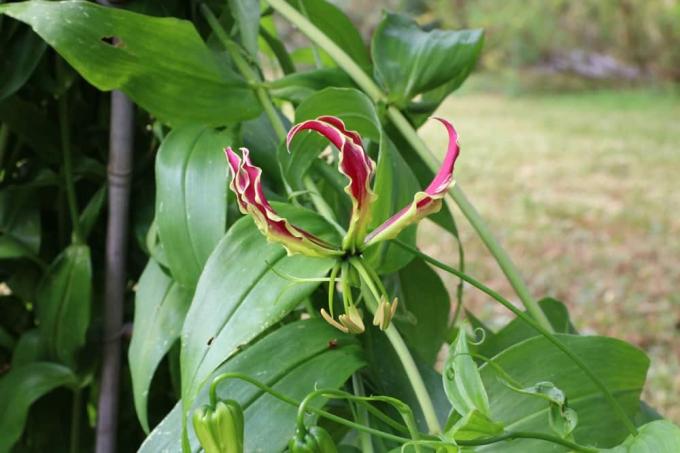
The end of Hibernation is the best time to grow a Crown of Glory. When the root tuber is removed from the planter or peat box, secondary tubers become visible. They can be cut off with a sharp knife. Seal the interfaces with charcoal powder. The young tubers are placed in small pots with a suitable substrate. Be careful with the extremely sensitive shoot tips.
When planting, make sure they point slightly upwards. This makes growing much easier. Cultivation takes place at a temperature of over 18°C. Then the first shoots will soon appear. From this point on they can be treated like adult plants.
A tuber that is a bit older and has reached a corresponding size can be divided in spring to plant the sections separately in individual tubs. However, small secondary bulbs often form on a tuber of the African climbing lily, which can be separated and then planted separately.
repot
The best way to repot is at the end of the dormant period, i.e. in February or March.
Fertilize
During the vegetation phase, the magnificent lily needs only a weakly concentrated liquid fertilizer every second watering.
hibernate
Because of its origin, the crown of glory knows only two seasons, the vegetation period from March to September and the growth pause from October to February. This explains why the withering of the flowers and shoots begins as early as August. In the end, all that remains is the rhizome-like tuber. It spends the winter in the planter at around 10°C. It does not need water or fertilizer during this time.
From March, the still dormant tuber should be awakened. Even if the root tuber has spent the winter in the planter, now - shortly before sprouting - it absolutely needs fresh substrate. It is then planted 3 to 5 cm deep in it.
- it now needs a bright but not full sun window seat
- the temperature range should be around 20 °C
- Gradually, the doses of water and fertilizer can be increased
After observing these specifications, the first shoots will appear after a short time. After just 8 to 10 weeks, the Gloriosa rothschildiana has become a magnificent eye-catcher again.
Cutting / poison content
This magnificent climbing lily not only looks decorative on a climbing frame. It also looks wonderful as a cut flower. It does not harm her if some shoots are cut off for the vase in summer. However, it should be noted that the plant is poisonous. Please note:
- wear gloves when cutting the plant!
- Also applies e.g. B. for disposing of the withered tendrils!
Although the toxin content is highest in the root tuber, the colchicine present in the shoots can cause severe symptoms of poisoning!
- in pregnant women, the poison can lead to genetic damage!
- Consumption of the potato-like tuber can lead to death!
Diseases / Pests
The crown of glory has proven to be far more resistant to fungal diseases. If the leaves change color unattractively, the plant is probably lacking in nitrogen. This deficiency can be quickly compensated with appropriate preparations.
aphids
An uncontrolled infestation with aphids leads to the death of the plant. Countermeasures:
- immediately isolate infested lilies, aphids migrate
- Rinse shoots thoroughly
- Spray repeatedly with soapy water
- use systemic insecticides sold as sprays or sticks
Plant
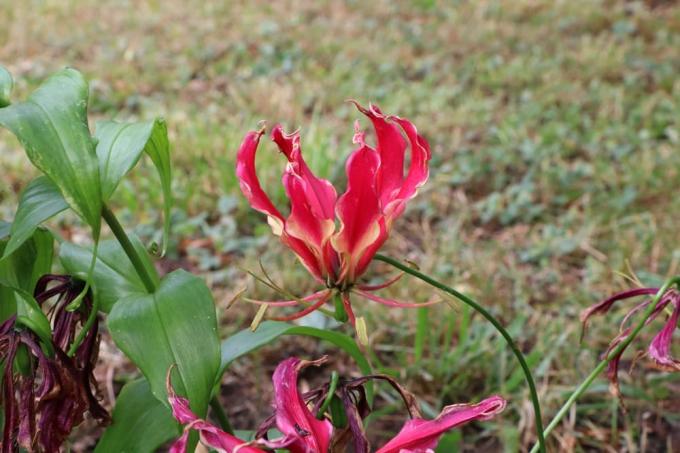
The African climbing lily belongs to the lily family and is therefore like others lilies planted as an onion. In contrast to the native lily species, however, its tuber is not frost hardy and must therefore be removed from the ground again in autumn. The African climbing lily is even better suited for a bucket with a trellis. It needs a sunny place and, due to its African origin, can also tolerate the blazing midday sun.
- The tuber of the African climbing lily is placed so deep in the ground that it is later covered by 2 to 3 cm of soil.
- After that, it may take a while before the first above-ground shoots appear.
- Later, however, the plant grows enormously and can reach a height of two meters by autumn.
So that the upper branches and leaves also receive sufficient moisture, it makes sense to Not only watering the plant over the root ball, but also the foliage in hot times to spray. fertilizer however, the African climbing lily should only get a little.
Care
- After flowering, the African climbing lily withers and completely retracts its foliage.
- During this time, it should be poured less and less slowly so that the soil and the tuber can dry out.
Withered leaves should only be removed when they are completely dry, because until then nutrients are still being stored in the tuber via these leaves. After that, the tuber needs its resting phase and is placed in a dark place with a temperature between 10 and 15 °C. However, a tuber that has been planted in a pot can also be stored together with the pot.
From March, the tuber can then be put back into a pot with fresh ones potting soil planted and placed on a bright window sill in a slightly warmer room in order to push them forward. There, the soil is watered immediately after the tuber has been planted and is kept evenly moist for the time that follows. In order not to injure the onion later, it is best to use a stick or a stick before planting another climbing aid put into the pot, which will later provide sufficient support for the long tendrils of the plant gives.
frequently asked Questions
The tuber gets an impetus to sprout when a transparent film is stretched over the plant pot. This creates a warm, humid climate that promotes budding.
After flowering, the plant forms capsule fruits. However, since these are scattered fruits, the time at which the seeds are harvested must be carefully timed, otherwise the seeds will quickly be scattered to the four winds.
 garden editorial
garden editorial I write about everything that interests me in my garden.
Learn more about climbing plants
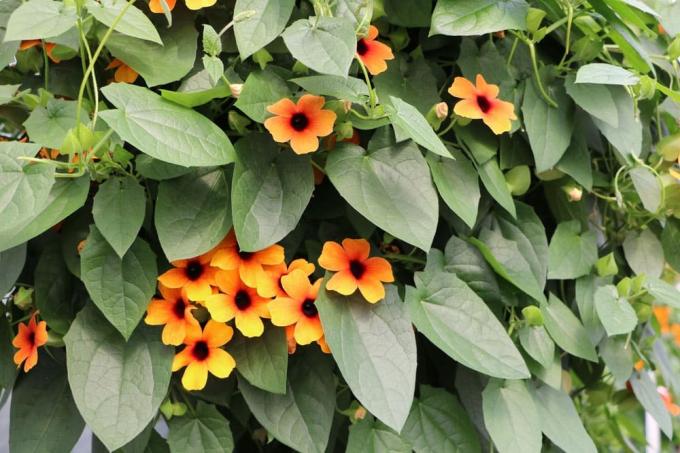
Is black-eyed Susan poisonous?
Black-eyed Susanne can delight all of our eyes with colorful flowers. But if small children or pets are around it, it is important that we also clarify whether it is possibly poisonous. The answer to that is clear and a little surprising!

Black-eyed Susanne, Thunbergia alata: Care from A – Z
Black-eyed Susanne is one of the most popular climbing plants. It is ideal for greening house walls, balconies, fences and pavilions. If you follow our care tips, you will enjoy the splendor of their flowers.
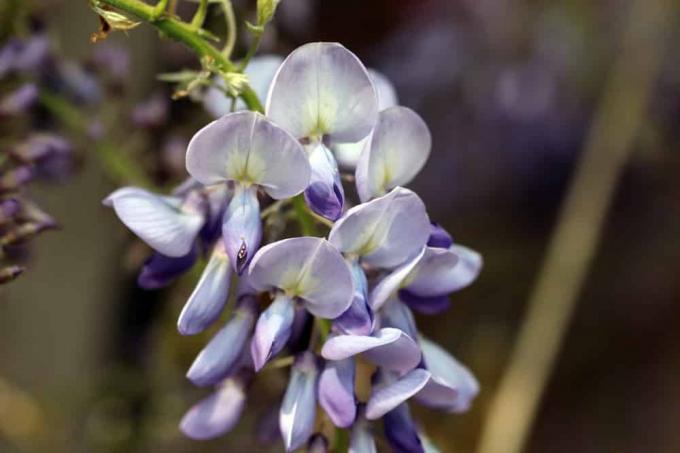
How fast does wisteria grow? | Information about growth
As its name suggests, the wisteria, as an intensive climber, enriches walls, trellis structures and other possibilities for spreading a magnificent, glowing blue sea of flowers. You can find out what you should consider when growing with us in a simple and understandable way.

How fast does Virginia creeper grow? | Information about growth
If you want a trellis or a house wall to be lushly greened, you will find a grateful partner in Virginia creeper. Over time, it can grow into large areas and, especially in autumn, enrich it with colorful foliage. Contact us for helpful information on growth.

Evergreen honeysuckle: care from A to Z
The evergreen honeysuckle is popular for greening walls or fences, because the creeper is green all year round and has beautiful delicate flowers. Although the honeysuckle is not very sensitive, it needs a minimum of care for it to develop well.

How fast does ivy grow? | Accelerate growth effectively
Ivy (Hedera helix) is a true climber that climbs up walls and house walls without any problems and can have a very decorative effect. Once it has taken root, it can literally overgrow large areas in a very short time. You can literally watch him grow.



